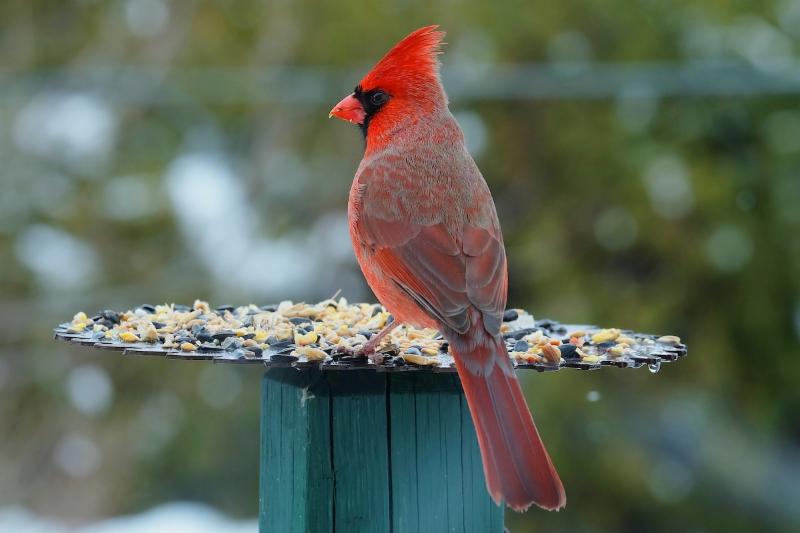
Cardinal Rules For Summer Bird Feeding Success
Read our Latest Newsletter Article
Written by Rob Symes from Wildlife Gardens
CARDINAL RULES FOR SUMMER BIRD FEEDING SUCCESS
Think of a bird swooping in on your backyard bird feeder, deftly landing within easy reach of your seed offerings, snatching its favorite treat, and quickly darting away with its prized selection. Probably, very few of you are picturing a cardinal, even though cardinals are the birds that most Wildlife Garden birdseed customers list first among their backyard bird feeder favorites. Instead of swooping, darting, snatching, or deftly approaching anything, cardinals appear to be more cautious–first surveying the territory from the edge of the yard, then advancing to a favorite perch near the feeder and, after determining that the coast is clear, gliding smoothly in on their final approach, fluttering to a stop on the edge of the feeder or even bypassing the feeder and landing on the ground underneath. Finally in position to begin feeding, cardinals will often still approach their first morsel suspiciously, cocking their head from side to side, questioning whether you would offer them anything but the best!
Finicky or not, cardinals have many endearing attributes that deservedly place them high on the list of summer bird feeding favorites. Begin with color. Whether framed against a snow-covered evergreen in winter or by lush summer green, the bright red color that gives the Northern Cardinal its name provides an instant connection to the male of the species. Importantly for cardinals, this visual attraction is not limited to the human eye, but is a major factor influencing female cardinals in the selection of a suitable mate. Perhaps surprisingly, the male’s color is not only an indication of overall fitness, but also provides specific insight into the male’s ability to help gather food for potential future offspring. This relationship arises because the red color that we see is the result of carotenoid pigments in the cardinal’s feathers. These pigments are not produced by the cardinal, but must be acquired from vegetation—red, yellow, and orange fruits, berries and seeds. The bright red of a male cardinal tells the female that he is a skilled forager, defends a desirable territory and will make a good provider. To reinforce his status as a good provider, cardinals are among the species that are known for “mate feeding.” At this time of year, you can frequently witness this behavior at your feeder with a male cardinal selecting a seed from the feeder and offering it to the female perched next to him. You can decide for yourself if she is impressed by his efforts!
Another favorite cardinal behavior that you can observe at this time of year, song production, is also related to mate attraction. We have all observed a male cardinal conspicuously perched at the top of a tall tree singing, but did you know that female cardinals also sing—often joining in a duet with the male as part of the pair bonding process? (Click on the link to hear the female cardinal call: Female Cardinal Birdsong)
Once the mate selection process is complete, cardinals are ready to move on to the next step —nesting. Preferring evergreens and shrubs, cardinals will nest in a wide variety of vegetation and surroundings, generally less than 15 feet high. Cardinals typically lay from 2-5 eggs, but, according to Cornell’s All About Birds website, more than 60% of nests fail to produce any offspring primarily due to weather and predation. Fortunately, cardinals typically have 2 or more broods each year, and, because they do not migrate, tend to have longer lifespans, so that populations continue to be stable. Also, nests in the vicinity of well-stocked bird feeders tend to produce more offspring. In addition to seeds, cardinals will also feed their young suet as a source of protein necessary for growth.
As we move later into summer, watch for another phase of cardinal behavior—fledgling care, as the proud parents introduce their young to you and your feeder. The young are easily identified by their darker, underdeveloped plumage and their lack of agility in flight and landing. As a result, the youngsters in the family will often end up on the ground under your feeder, where you will be able to observe both Mom and Dad patiently performing the skill that was previewed in the mate feeding process—selecting one seed and offering it to their youngsters standing right next to them!
Want to attract cardinals to a feeder in your own backyard this summer? Remember, cardinals, especially young, are less agile than some of our other favorite feeder birds—provide them with a wide perched or platform feeder filled with sunflower, safflower, or Wildlife Garden Supreme birdseed mix and welcome the whole cardinal family!
Don’t forget Dad loves to feed birds!
Check out great cardinal bird feeders and mounting options now in stock at Terra Depot